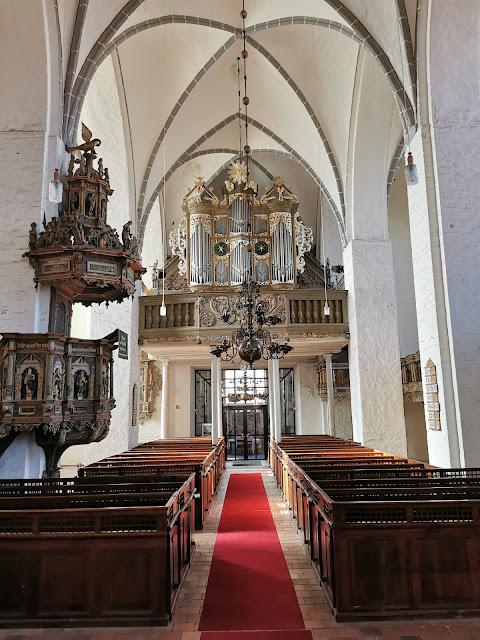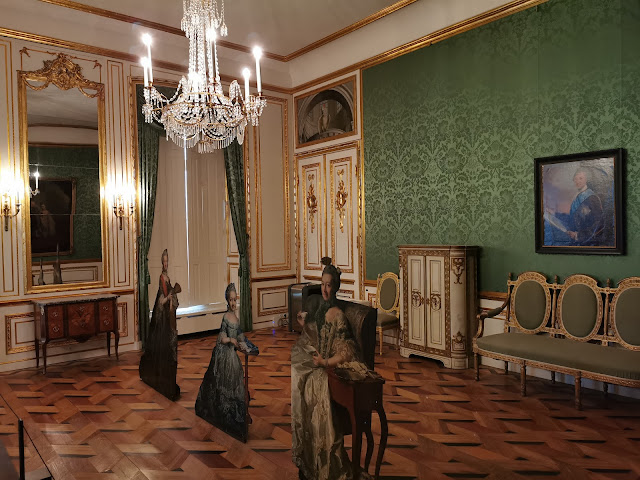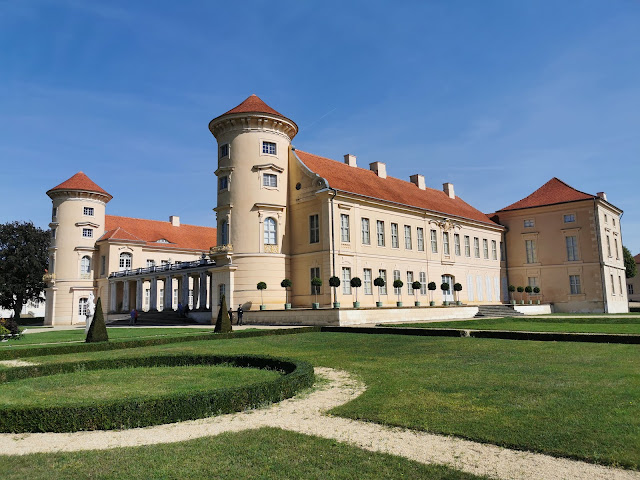On another October weekend, we decided to visit a few towns to the east of Berlin and then end the trip in Poland. Our first stop was the town of Müncheberg which we reached after taking a train to the train station, located quite far from the city center, and then a bus that took us from the station to the old town. Here we first saw the Berliner Tor, one of the only two defensive towers once part of the medieval walls which encircled the city, it is colloquially referred to as the powder tower, due to its previous use as such. From there we then walked following part of the surviving city walls and then reached the center of town where the St. Marien church was located. This gothic brick building, which was badly damaged and burned during WWII and rebuilt in the 1990s, was unfortunately closed so we could see it from the outside. It presented a rather unusual bell tower, attached to the church through a suspended bridge-like walkway over a pointed arch. Like the church, much of the town suffered devastation during the last war, and so its historical center has now mostly disappeared and been replaced by typical Soviet-style block buildings known as plattenbau. On the eastern end of town, we then saw the other remaining defensive tower, Küstriner Torturm, quite plain in its circular simple form. After our walk around the center, we then took another bus this time bringing us to the next town, Seelow. Seelow was the location of one of the last major pitched battles in Europe during the Second World War known as the Battle of the Seelow Heights. In this battle, from 16 to 19 April 1945, Soviet troops under Marshal Zhukov opened the way to Berlin, resulting in the town being largely destroyed. Once there we walked through the town center, passing by the 19th-century neoclassical church rebuilt after the war. Just east of the city center we then reached the Gedenkstätte Seelower Höhen, the memorial to the famous battle. Erected in 1945, with the museum then added in 1972, it features a monument showing a soldier of the Red Army with a submachine gun standing next to the tower of a destroyed German tank. Around it are the graves of over 7,000 Soviet soldiers, most of which were never found and buried, and thus with only a few tombstones having names on them. Also on-site are five military devices, a cannon, a grenade launcher, a howitzer, a Katyusha rocket launcher, and a T-34 tank. As the name suggests the memorial sits on a hill overlooking the plain formed by the Oder river all the way to the nearby Polish border. After walking around the grounds and admiring and learning from this sad part of history, we then headed back into town. From there we were then able to take a bus to the train station, a few kilometers north of town and from there get a ride to the town of Küstrin-Kietz, right on the border with Poland. From here we then decided to walk over the border and into the town of Kostrzyn nad Odrą. As we crossed the Odra/Oder River, which forms a natural border between the two countries, we then entered the grounds of the former Kostrzyn Fortress. Once this was the old city of Küstrin, which like the typical medieval towns featured a castle, churches, and an old town. Beginning in the 16th century the town was then surrounded by a fortification, in the typical Italian style, made to endure modern gunpowder warfare. The fortress was used throughout the centuries and particularly during WWII when, following the devastations of the war, and the siege in 1945 of the advancing Red Army, the town inside was completely destroyed. Now only the streets outline remains, with just a few foundations of the main buildings, such as the castle, cathedral, and town hall testifying that there was once a city there. We entered the complex through the northwestern gate, Brama Berlińska, the best-preserved city gate. From there we then walked through the streets of what was once the old town, with trees and plants growing among the former city blocks. Past the ruins of the church and castle, we then went on top of the Bastion Brandenburgia from where we then had a great view of the Odra river flowing right below the ramparts. After enjoying the view, despite the light rain that started drizzling, we then walked around the rest of the fortress and then out towards the modern city center. We walked over a bridge crossing the Warta River, which just a couple of hundred meters further down joins the Odra River, and then reached the center of Kostrzyn. Here we stopped at a place called Artisan, where Ania had a salad while I had a kotlet schabowy with mashed potatoes and cabbage with pepper plus a beer. After lunch, we then headed to a nearby supermarket where we then bought quite some groceries to bring home with us. We headed to the bus station and from there took a bus back to Germany, switching in Küstrin-Kietz where we then took the train back to Berlin.
 |
| The Berliner Tor in Müncheberg |
 |
| The medieval city walls |
 |
| The church of St. Marien |
 |
| The Küstriner Torturm |
 |
The church in Seelow
 | | The Gedenkstätte Seelower Höhen |
|
 |
| The monument with the Red Army soldier |
 |
| The T-34 tank and Katyusha rocket launcher |
 |
| The Odrą river near Kostrzyn |
 |
| The Brama Berlińska |
 |
| The now empty streets of old Küstrin |
 |
| View of the river from the bastions |
























































